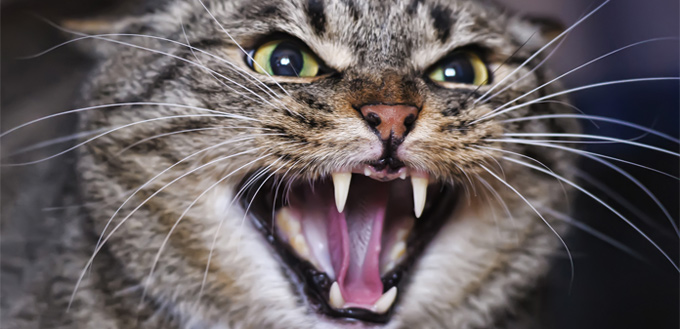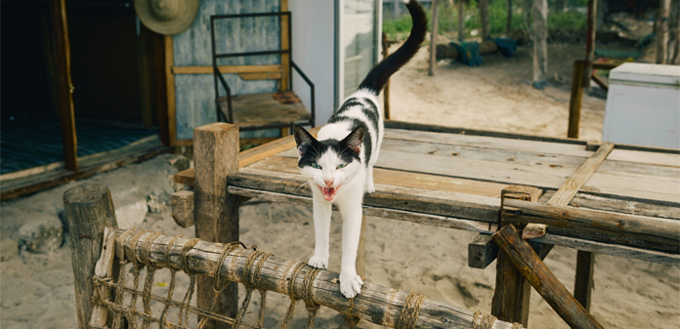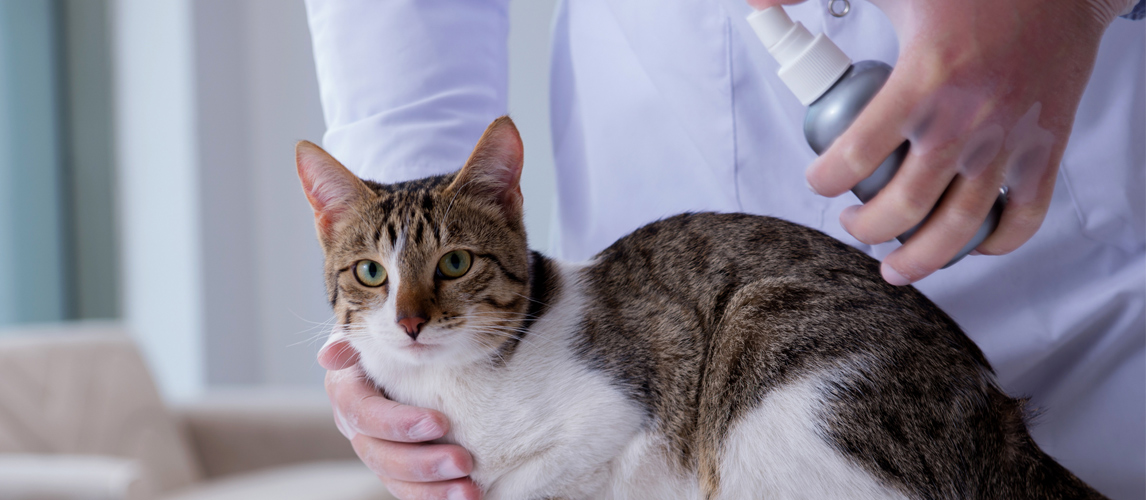If you’ve been watching My Cat from Hell you’d really wonder if hellish aggression is really innate in these creatures. After all, they are still very much related to some of the world’s meanest and fiercest cats in the wild. With claws that can rival that of Freddy Krueger’s or even Wolverine plus eyes that are so sharp they can stab you right through the heart, cats have earned for themselves the distinction of being one of the planet’s meanest creatures. But do they really deserve such label? Or is there more to feline aggression than man has ever cared to comprehend?

Feline Aggression: Deciphering the Symptoms
Cats are natural predators, no question about that. And no predator will ever survive in the wild without some form or level of aggression. And while our cats have been domesticated for many millennia, there’s still that predatory gene lying in them. While it will be especially difficult to really manage feline aggression, let alone treat it, one can always feel more confident by recognizing the different manifestations of feline aggression.
The American Society for the Prevention of Cruelty to Animals defines animal aggression as a violent or hostile behavior exhibited by animals primarily to intimidate or even dominate another animal or living organism like a man. According to the organization, aggression in cats is quite common. As a matter of fact, less than a third of all cats that end up in shelters are brought there because of aggression. The aggression can be directed to other cats, other pets, or worse the pet owner and his family.
So how do you know if your cat has this aggressive tendency?
Feline aggression can come in three different behaviors: defensive, offensive, and overt.
- Defensive postures
Defensive postures are shown in an attempt to make itself smaller. It also puts the cat in a highly protective manner. You may observe your cat to crouch, flatten its ears, hiss, turn away from you, raise its hackles, swat at you, or even tuck its head. The whiskers may also be retracted; in a fearful feline these are panned out in an attempt to keep its distance from the danger. Its pupils will be dilated so it can assess as much of the environment as it possibly can. It is simply telling you to back off or else it will have to defend itself.
- Offensive postures
First, the pupils will be constricted. This is because of the heightened stimulation of the sympathetic nervous system, triggering the fight or flight response. Unfortunately, in aggressive cats it’s always the ‘fight’ mechanism that is activated; never the ‘flight’. The sudden rush of epinephrine or adrenaline stimulates the pupils of the eyes to become constricted in an effort to focus on a target. This is one true characteristic of an offensive cat.
It may stiffen its legs, especially its hind legs, in an attempt to appear taller. This is often combined with its behind raised with the back gently sloping towards its head as if ready to pounce. Its hackles are also raised to give it the appearance of a more menacing look. Its ears may be flattened towards the back of its head or standing upright as if listening for any sign of fear in you. It will also glue its eyes on you, move towards you, and let out a growl. Its tail will be stiff, too. You might even hear it yowl, growl, or howl.
- Overt aggressive postures
Regardless of whether a cat is defensive or offensive, overt aggression is typically characterized by striking its target with its paws either swatting or clawing. There is also fighting and biting. Scratching is a major sign to look out for. Shrieking and growling are also telltale signs of an overtly aggressive feline.
In really aggressive kitties it may roll onto its back or sides and expose all weapons in its arsenal – both teeth and claws. In many cases the cat may attempt to grab the ‘enemy’ and draw it closer to its wide open mouth so it can sink in its razor sharp teeth. Its claws will double the pain as it sinks into its target.
Common Reasons for Aggression in Cats
There are many potential causes of aggression in cats. These can also be considered as the different types of feline aggression. Your understanding of these causes can help you prevent if not managed this catty behaviour.
- Medical
Feline aggression is often characteristic of cats that are diagnosed with hyperthyroidism, nervous system disorders, hormonal or metabolic problems, and liver disorders. This may have something to do with alterations in the cat’s perceptions of things around it. While it is presumptive, cat behaviorists believe that minute changes in the cat’s brain can somehow trigger aggressive tendencies.

Cats that are exposed to lead or are diagnosed with bacterial or fungal infections may also exhibit aggression. Again, these can be attributed to irritation of the central nervous system, leading to stimulation of that part of the brain that regulates behavior including aggression.
- Fear
This behavior is typically associated with a threat that the cat cannot escape. It is often related with an unfamiliar stimulus. For instance, bringing a new cat or pet home or perhaps having a stranger to visit your house. Even a visit to the vet can trigger fear aggression. It’s the cat’s way of saying it doesn’t want that kind of stimulus. It is mostly based on the cat’s prior experiences that may not be all that pleasing for the kitty.
- Territorialism
Most cats are highly territorial. They want to keep their ‘place’ as theirs. Any activity that is perceived by cats as an intrusion into their territory will often be met with aggression. Even persons can be attacked if the cat perceives the individual to be violating the ‘space’ of the cat. This is often the case when introducing a new cat into the household where the existing cat may show aggression towards the newcomer.
- Inadequate play experiences with littermates
Kitties that never had the chance to play with their littermates or hadn’t had the opportunity to really enjoy playing may show play aggression. When cats grow with their littermates they learn that scratching or biting too hard can lead to their littermates not wanting to play anymore. As such, they learn to temper their ‘playfulness’. Unfortunately, cats that never had the chance to learn how to play ‘nicely’ tend to bite and scratch their pet parents believing that it is the correct way of playing.
- Status or social dominance
Cats are highly independent creatures. Unfortunately, some can exhibit dominance over others even over their human masters. They typically block passageways or even swat at other pets when these attempt to pass through. The best approach here is to ignore the cat completely as giving it unnecessary attention – even discouraging it from doing the behavior – can only reinforce the aggression. Wait for it to be in a relaxed mode before attempting anything.
- Overstimulation
It is not really known what makes cats suddenly snap when being petted. This typically occurs during certain activities that are characterized by prolonged handling such as during grooming, bathing, and nail trimming. Cats are believed to want to have control over how long they can and should be petted. If the petting session is longer than what is comfortable to them they can go into an aggressive mode.
Related Post: Best Cat Nail Clippers
- Redirected aggression
There is another type of aggression that also results from overstimulation. This is called redirected aggression. The problem with this one is that the cat cannot respond directly to the stimulus. For instance, if there is a loud noise the cat cannot really complain except to display very aggressive behavior. In some instances, if the cat just came from a fight with another cat there’s a chance that it might redirect its aggression to another cat or to its pet parent.
- Pain
Pain is almost always a trigger for aggression in an effort to protect the painful part. If a cat is in pain it will do almost anything to prevent anything or even anyone from ever making the pain worse. It will not want to be touched or even moved a bit. The good news is that once the pain has subsided the aggression typically goes away, too.
- Litter protection
Queens are known to be highly protective of their litter. If anyone or anything tries to get near its litter there’s a good chance it will try to display aggressive behavior. This is especially true for very young litter or a queen that has just given birth. Like pain-induced aggression, maternal aggression typically subsides as the kittens grow older.
Related Post: Best Cat Litter
- Predatory instincts
Felines are natural predators. Most cat behaviorists don’t actually consider predation as necessarily a form of aggression in cats because it’s a very natural instinct for them.
However, it can still pose a threat to the safety of other pets or even humans in the household. That is why cat toys and other safer and more constructive methods should be used to help kitties act out their predatory instincts.
Managing aggression in cats is more about understanding what causes these pets to behave this way. In most cases the problem usually goes away if the underlying problem is addressed. If you’re not comfortable dealing with your pet’s aggression, your vet can help.
Sources:
- Thomas R.Gregg, Brain Structures And Neurotansmitters Regulating Aggression In Cats: Implications For Human Aggression, ScienceDirect
- Aggression to Humans, International Cat Care
- Aggression in Cats Toward People, Best Friends Animal Society






